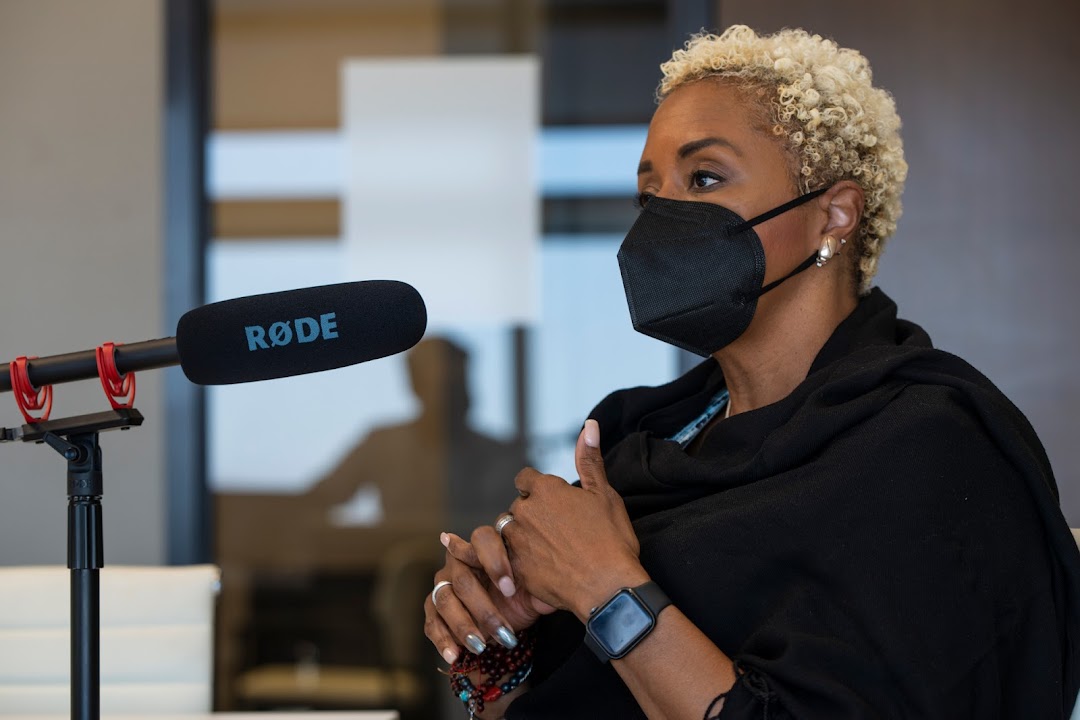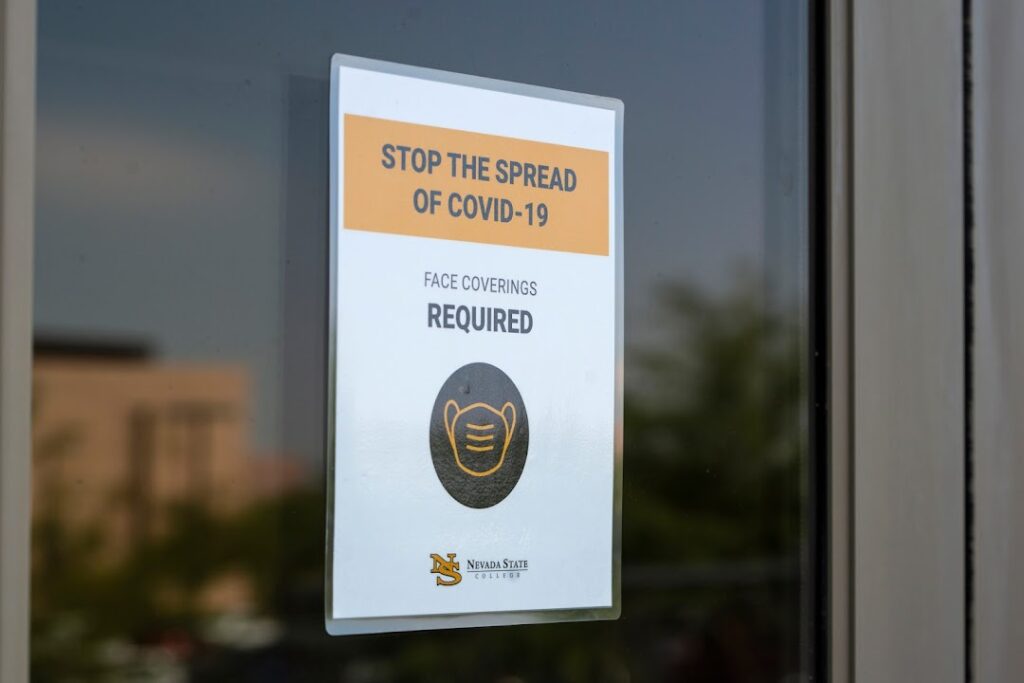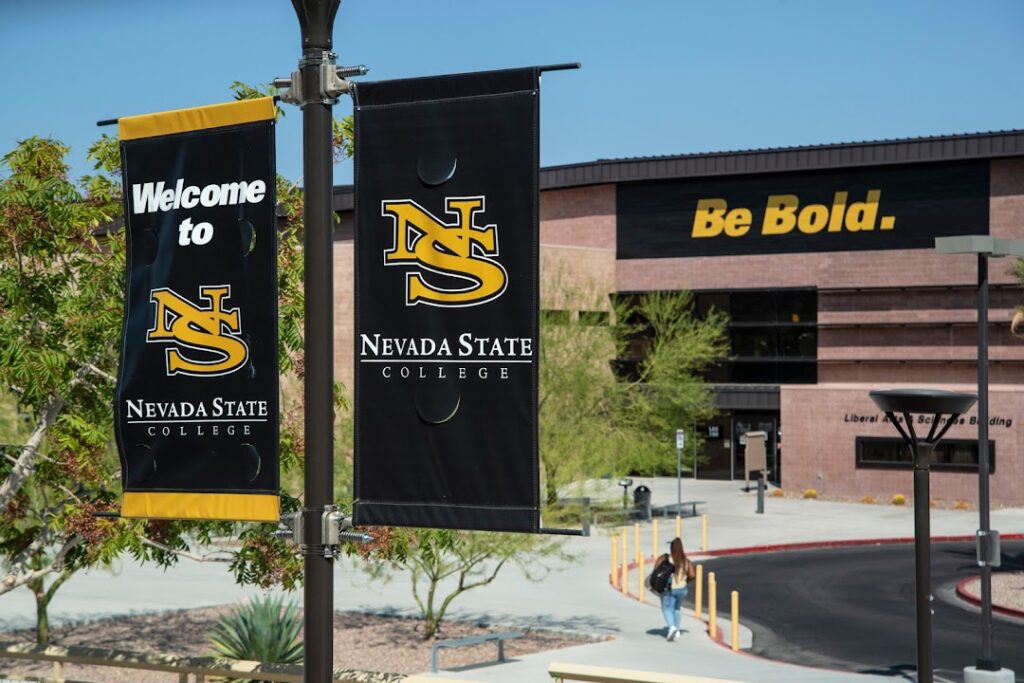Indy Q+A: Nevada State College president on vaccine mandates, explosive enrollment growth

DeRionne Pollard made history earlier this year when the Board of Regents approved her as the next president of Nevada State College — making her the first Black woman ever permanently appointed to head up a Nevada higher education institution.
Pollard — who comes by way of a 10-year stint in charge of Montgomery College in Maryland, an institution with 50,000 students (equivalent to roughly half of all Nevada public college and university students) — is looking to make history at the state’s youngest higher education institute and its only non-university, non-community college public higher education school.
“We [Nevada State College] operate in a whole different lane,” Pollard said. “I kind of like that idea of being able to step into some place and say, ‘How do we [turn] up the volume?’”
Founded in 2002, Nevada State — a four-year school that serves as a middle ground between the two-year community colleges and the state’s two four-year research universities — is by far the state’s newest higher education institution at just 19 years old. But it’s also the system’s fastest-growing.
In its first decade of existence, the student headcount at Nevada State rose to 3,200 students. But between 2015 and 2020, it catapulted from 3,500 students to nearly 7,300, almost entirely because of an explosion in minority student enrollment.
Even during the pandemic, when enrollments dropped across the board elsewhere — sometimes by as much as 10 percent — the college saw its headcount rise by more than 1,700.
With that growth has come new issues — all complicated by the lingering pandemic and all the baggage the virus entails.
The Nevada Independent sat down with Pollard to discuss those issues and more. This interview has been edited for length and clarity.
The Nevada Independent: Digging into the question of diversity, NSC is among the most diverse institutions in Nevada in large part because we’ve seen an explosion in the number of minority students, essentially doubling since 2015. In that time, though, faculty diversity has lagged, as it has at other institutions. How do you plan on addressing that disparity?
DeRionne Pollard: Well I think it is an alignment around what I like to call these four Ps. You have to look at policy, procedures, practices and promise, and the reality about this is, do we have policies to speak, thoughtfully and deliberately, to our commitments in the space and really articulate the pathway forward?
The second part of that is then, what are our procedures? Are we committed around the work of looking at how we diversify our access pools of people that come in? How do we go about doing that? Do we have the appropriate infrastructure in place to do that? What does that look like within a search committee?
When you are reviewing candidates, have we done the types of training that's necessary for search committees to be actively engaged in that? And then at the end of the day, are we fully committed to what this looks like when we actualize — because it does nothing to bring people to an organization, and once they get here, they don't have a lived experience that makes them feel valued, makes them feel welcomed, makes them feel this organization is inclusive.
When I applied for this job, we had these series of open forums and someone asked me, ‘What would you do about diversity at Nevada State College’ and I was quite perplexed by that. I said that is a certain level of arrogance you'd expect me to walk into this organization with, and I reject that. My perspective is that I have to come and know this organization intimately and study exactly all of the parts there, because it is a system. You don't just get a faculty that reflects the student body without a level of intentionality about that.
Speaking with faculty and students across the system, morale has taken a hit over the last year and a half as the pandemic has squeezed every level of higher education. How do you address that low morale?
When we've been talking about COVID, everyone has been talking about it from the student perspective, which I think is very important. We can talk about the realities of this for our students,but as I tell people — our employees, our faculty and staff — guess what? They have families, they have communities of which they're a part, they've had to address some really significant issues that go with that.
So this idea, one, is having leadership acknowledge the issue. I was on a panel … and we were talking about this and you [would have] thought I said something particularly remarkable when I actually said ‘let's talk about the stress and strain.’ As a college president, my job is to acknowledge that. If we operate in this fact, that, ‘Oh, everything's fine and dandy, we've delivered all this education, we met students where they are.’ We haven't talked about the backside of that, about what it took to make that happen.
So for me, I saw it, and I talked with our faculty and staff. Even since I've been here, I will walk around with people and say, ‘How's it going,’ and to understand that lived experience to acknowledge it — that's a huge part of what leadership should do, is acknowledge it. And then secondly, how can I put supports in place to remove barriers. That means having substantive conversation about class load, to talk about the IT structure that needs to be there, to talk about what it is we're trying to get toward in the future, to talk about issues of salary compression (the small or decreasing difference between stagnant salaries for older employees and higher relative salaries for new hires) — those are things that we need to acknowledge and recognize and think about. How do I put supports in place to respond to that?

Coming into a role of managing this pandemic at an institutional level, essentially at an advanced stage where we have the vaccine, but the virus is still an issue — what does successful COVID management look like for you?
I think it's a very clear articulation of what your mission is now, as a result of COVID-19. How are you creating a future-proof organization that looks at how one manages a new curriculum of what we need to know? As a result of the economy changing so much, what are the new pathways to work? What does it look like in terms of how you imagine the employee experience and the employee nature of work? How do you work to keep the organization safe, and make sure that you are articulating a set of expectations for employees to students and visitors [and] is very clear about how you do that?
You have to be hyper vigilant around communication. That to me is the most defining competency of the college presidency, or the leadership, at this particular point. How to use multiple mediums, how to be very deliberate about various platforms, how to have consistency in your message so that people know that you said it here, you said it here, you said here, it's always the same message.
The other thing for me, and this is a really hard thing for higher education, we’ve got to be able to hold two thoughts in our brains at the same time — that our students are learners, but they're also consumers. When they are in the classroom, they are learners, and you are treating them with the academic promise and potential with what those faculty can do in that space. But when they're outside of that classroom, they're consumers. They have the ability to take their dollars someplace else if they want to.
What is our value add as an organization, how are we talking about high-impact practices and implementing them? How are we making sure that our campus feels welcoming to our students and also at the same time that they can feel safe.
Those are things we have to hold in our head at the same time in higher ed. We struggle with that notion because we say ‘Oh, this isn't a business, they're not consumers’ — none of us work here for free, and none of our students go here for free. It's not a volunteer organization for anybody. So as a result of that, we've got to think about how we deliver on our mission in an evolving manner and not be so slow about it.
Are you concerned that NSC’s student enrollment growth could be negatively affected by the student COVID vaccine mandate set for Nov. 1?
There may be an impact. I don't doubt that. What I will offer to you though is that this is the right thing to be done. I believe this deeply, that part of our commitment as an institution is to be the space where there is safety, both for students who want to come here and explore different intellectual ideas, but also in terms of health and safety.
At the end of the day, our job is to work to craft the environment that we know is necessary for that. All of the compelling science indicates that vaccines are the way to lessen illness and help prevent death. I want you to have to be able to come on our campus, and not have to think about the fact that I may be exposed here.
Will we, as an organization, see some enrollment loss? Inevitably. But this is part of what's happening across the nation. Enrollment is contracting in higher education. The students have other options they can pursue if they want to go someplace else because they felt that this vaccine is an unwieldy mistress that’s asked too much of them, and they don't want to be a part of that. I want to support them in being where they think they can be and be safe at.
But for the clear majority of our students, the majority of our employees, they want that type of environment, and it's our obligation and commitment to do that.
And on the employee side, the Board of Regents will consider a wide-reaching employee vaccine mandate later this week. Are there concerns there will be employee attrition, too?
I don't know that. What I would tell you right now is that we have about 81 percent of Nevada State employees who have already received the vaccine, and have demonstrated proof of that. Others still have a few more weeks in order to make that possible.
So maybe we'll see some of that occur. Whether it be some natural attrition, people’ll say, ‘retire now?’ I think there are multiple reasons why any of this could be happening now, there are a lot of folks who are saying, ‘You know what, the stress in higher education is one I don't want to be a part of, maybe there's a vaccine mandate, I don't want to be a part of this.’
As I said of the students — you have options. If you are no longer wanting to be an employee of Nevada State College because there is a mandatory vaccine that we're asking employees to take to help keep us safe, as a community, then [what] I want to do is help you make the best decisions for you and your family. And if you have another employment [opportunity] lined up, I want to help support that … but there's something about being an anchor institution. There's something about being an institution of higher education right now and that should mean something.

On the issue of enrollment, the growth at NSC has been uncharacteristic compared either to itself, or other Nevada institutions or even nationwide trends. So what does sustainable enrollment growth look like over the next five or 10 years?
We know that Nevada State College is created for a distinctive purpose, and one, we want to get more firmly entrenched in our mission. We were created because someone said they didn't want to do what we were doing, they didn't know how to do what we were doing, or they didn't think they could do what we're doing. So as a result of that, this institution came to be.
At the same time, we have to be very thoughtful. There are macro trends that we have to be prepared to respond to and know that some of this, we have no control over. There have been predictions on the contraction of higher education enrollment for years, and we've seen it happen. At first it was the Northeast, then it started to the Midwest, you'll see some of the Northwest, and of course they said the two main population centers of a country as we see right now, Southeast and Southwest are going to continue to see growth. But the challenges around resources will continue to be an issue as well.
When we talk about expansion and growth, to what degree is the budget — and deep, system-wide budget cuts — a limiting factor for NSC?
There's going to be a need to revisit the funding formula, I do believe, because right now the budget has really incented growth. It is built around outcomes and growth. And at some point, you move into a place where you have to also build capacity. And right now, Nevada State College has been growing so fast, those resources [that] have come to help us do that type of growth have been important, but when that growth slows and you're still trying to build infrastructure, you've got to figure out a way in order to be able to say, ‘there are capital needs.’
You want to keep our class sizes at a reasonable level, you want to be able to have robust support services, you want to tap into those communities that have been underserved or have been ignored. It's important for us to do that in Nevada State College. Should we also be thinking about how we're delivering our mission more broadly across the state of Nevada? Those are things that will require some level of investment.
